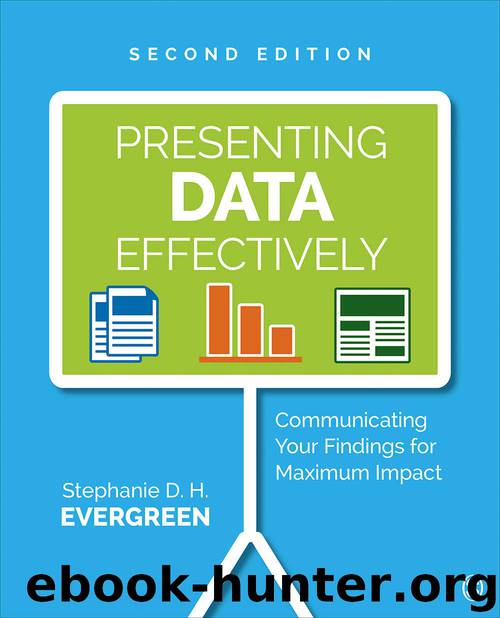Presenting Data Effectively: Communicating Your Findings for Maximum Impact by Stephanie D. H. Evergreen

Author:Stephanie D. H. Evergreen [Evergreen, Stephanie D. H.]
Language: eng
Format: epub, azw3
Publisher: SAGE Publications
Published: 2017-05-22T23:00:00+00:00
This example shows a sidebar that contains a small success case study. The content can stand on its own and serves as a complement to the narrative, making it suitable material for a sidebar. The sidebar is established with a gray background, and while color is commonly used to demarcate separate space, it is not totally necessary. As discussed in Chapter 4, on color, you need to be careful that the sidebar background color is light enough for good legibility.
What is more compulsory is that the sidebar content is set in a different font, so that it is not confused with the narrative text. In fact, sidebars are frequently set in a third font, not the one used for the text or the one used for the headings of the report. Often, the third font is a sans serif that complements the other two. Identifying three complementary fonts can be tricky. Some font-matching resources are listed at the end of this chapter, but as a backup plan you can set your sidebars in the same font as your sans serif report headings and get the job done. Be attentive to the line length here—I used a condensed font for the sidebar in Figure 3.28 to get closer to the ideal of 8 to 12 words per line, which is discussed in Chapter 5, on arrangement.
Download
Presenting Data Effectively: Communicating Your Findings for Maximum Impact by Stephanie D. H. Evergreen.azw3
This site does not store any files on its server. We only index and link to content provided by other sites. Please contact the content providers to delete copyright contents if any and email us, we'll remove relevant links or contents immediately.
Nudge - Improving Decisions about Health, Wealth, and Happiness by Thaler Sunstein(7553)
Deep Work by Cal Newport(6856)
Principles: Life and Work by Ray Dalio(6178)
Factfulness: Ten Reasons We're Wrong About the World – and Why Things Are Better Than You Think by Hans Rosling(4675)
The Doodle Revolution by Sunni Brown(4667)
Eat That Frog! by Brian Tracy(4411)
Thinking in Bets by Annie Duke(4140)
Hyperfocus by Chris Bailey(4031)
Visual Intelligence by Amy E. Herman(3710)
Writing Your Dissertation in Fifteen Minutes a Day by Joan Bolker(3660)
Ogilvy on Advertising by David Ogilvy(3485)
How to Win Friends and Influence People in the Digital Age by Dale Carnegie & Associates(3485)
Hidden Persuasion: 33 psychological influence techniques in advertising by Marc Andrews & Matthijs van Leeuwen & Rick van Baaren(3454)
How to win friends and influence people by Dale Carnegie(3382)
The Pixar Touch by David A. Price(3345)
Schaum's Quick Guide to Writing Great Short Stories by Margaret Lucke(3304)
Deep Work: Rules for Focused Success in a Distracted World by Cal Newport(3129)
Work Clean by Dan Charnas(3036)
The Slow Fix: Solve Problems, Work Smarter, and Live Better In a World Addicted to Speed by Carl Honore(2939)
